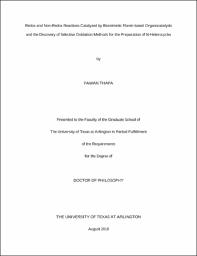
ATTENTION: The works hosted here are being migrated to a new repository that will consolidate resources, improve discoverability, and better show UTA's research impact on the global community. We will update authors as the migration progresses. Please see MavMatrix for more information.
Show simple item record
| dc.contributor.advisor | Foss, Frank W. | |
| dc.creator | Thapa, Pawan | |
| dc.date.accessioned | 2019-08-29T21:01:27Z | |
| dc.date.available | 2019-08-29T21:01:27Z | |
| dc.date.created | 2018-08 | |
| dc.date.issued | 2018-08-08 | |
| dc.date.submitted | August 2018 | |
| dc.identifier.uri | http://hdl.handle.net/10106/28656 | |
| dc.description.abstract | In nature, flavoproteins (FMN and FAD) are known to catalyze several chemical transformations which play a vital role in the growth, development, and survival of organisms. They are involved in one-electron and two-electron transfer reactions, photo-induced electron transfer reactions, dehydrogenase reactions, oxidative atom transfer reactions and also rare non-redox reactions. Their enhanced stability and ability to turn over in presence of dioxygen has inspired synthetic chemists, including our group, to perform biomimetic transformations within a range of function of natural flavoproteins.
In chapter 1, both intramolecular and intermolecular dehydrogenative coupling between the alpha carbon of tertiary amines and various nitrogen, phosphorus, and carbon-based nucleophiles are reported. This study signifies the flavin dependent oxidase type chemistry promoted by synthetic flavins, rendering the catalytic construction of some sophisticated heterocycles through an atom economical and aerobic approach. Mechanistic studies with different radical probes suggest the involvement of radical intermediates in the reaction cycle. Moreover, intramolecular kinetic isotope studies performed reveal possibility of Hydrogen atom abstraction being rate determining step.
In chapter 2, a non-redox type of chemistry is disclosed. A subclass of riboflavin mimics was found to catalyze C-C bond formation by activating small molecules in a new manner. This approach was successfully applied to synthesize various industrially important dyes and chemical reagents. Additionally, the relationship discovered between molecular structure and catalytic function of riboflavin mimics in these new chemical reactions revealed a plausible explanation for the function of natural riboflavin-dependent hydroxynitrilase enzymes in biological system. Mechanistic studies using nuclear magnetic resonance (NMR) spectroscopy, UV-vis spectroscopy and electron paramagnetic resonance (EPR) spectroscopy showed a possible frustrated lewis-pair (FLP) type of interaction between aldehydes and flavin mimics.
In chapter 3, studies on benzimidazole synthesis by iron catalysts will be discussed. 1,2-disubstituted benzimidazoles serve as important class of molecules in several area of chemistry including drug discovery, catalysis, etc. Our investigation in this area with redox active iron catalysts revealed N,N’-disubstituted-ortho-phenylenediamine substrates being superior to N,N-disubstituted-ortho-phenylenediamines in generating 1,2-disubstituted benzimidazoles. Extensive UV-vis spectroscopy studies and kinetic studies have been performed in addition to EPR spectroscopy to understand the nature of mechanism. Both Lewis acid property and redox active property of iron trichloride are thought to play a significant role in catalysis. Smooth complex formation between N,N’-disubstituted-ortho-phenylenediamine substrates and iron catalyst provides the driving force for the electron transfer process to form productive iminium intermediate.
A simple method for chemo-selective oxidation of isoindolines to isoindolinones was also studied in chapter 4. This method utilizes no catalyst, no additive, mild condition and is highlighted as just solvent mediated transformation. Mechanistic investigation shows hydrogen atom abstraction process leading to isoindole intermediates which further binds to oxygen to give desired isoindolinones products. | |
| dc.format.mimetype | application/pdf | |
| dc.language.iso | en_US | |
| dc.subject | Riboflavin mimics | |
| dc.subject | Cross dehydrogenative coupling | |
| dc.subject | Frustrated Lewis pair | |
| dc.subject | Benzimidazoles | |
| dc.subject | Iron catalysis | |
| dc.subject | Chemoselective oxidation | |
| dc.title | Redox and Non-Redox Reactions Catalyzed by Biomimetic Flavin-based Organocatalysts and the Discovery of Selective Oxidation Methods for the Preparation of N-Heterocycles | |
| dc.type | Thesis | |
| dc.degree.department | Chemistry and Biochemistry | |
| dc.degree.name | Doctor of Philosophy in Chemistry | |
| dc.date.updated | 2019-08-29T21:01:28Z | |
| thesis.degree.department | Chemistry and Biochemistry | |
| thesis.degree.grantor | The University of Texas at Arlington | |
| thesis.degree.level | Doctoral | |
| thesis.degree.name | Doctor of Philosophy in Chemistry | |
| dc.type.material | text | |
| dc.creator.orcid | 0000-0003-1608-5363 | |
Files in this item
- Name:
- THAPA-DISSERTATION-2018.pdf
- Size:
- 34.04Mb
- Format:
- PDF
This item appears in the following Collection(s)
Show simple item record


